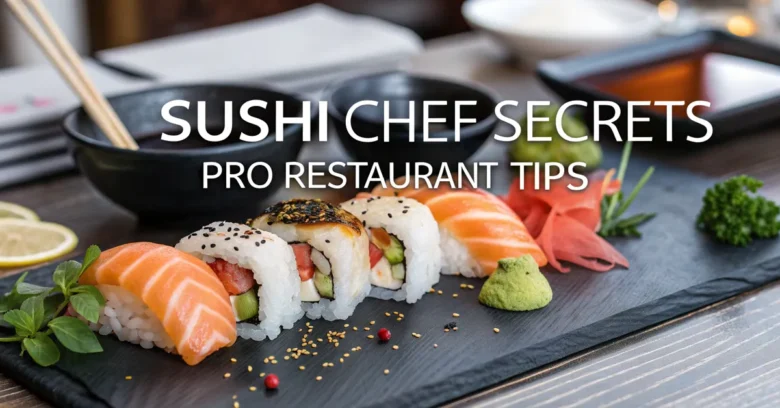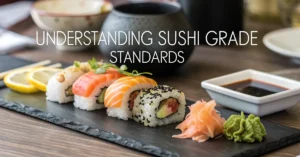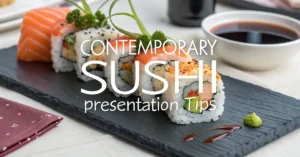Want to know how to make sushi like the pros? It is more than just rolling rice and fish. It is a craft honed through years of dedication. Many sushi chefs guard their techniques like treasure. But today, you’re getting a peek behind the curtain.
From selecting the freshest ingredients to mastering the art of knife work, there’s much to discover. These chef secrets will elevate your sushi game, whether you are a home cook or a serious enthusiast. Get ready to learn the pro tips that separate the good from the exceptional.
Sushi Chef Secrets: Pro Restaurant Tips
Choosing the Right Rice: The Foundation of Great Sushi
Sushi rice isn’t just any rice. It is specially cultivated short-grain rice, often koshihikari or sasanisiki varieties. These types have a high starch content, which gives the cooked rice its signature stickiness and chewy texture.
Why Short-Grain?
Short-grain rice contains more amylopectin, a type of starch. Amylopectin results in a stickier cooked grain. This is essential for holding the sushi’s shape. Long-grain rice, like basmati, is fluffy and separate. It will not work for sushi.
Washing is Key
Before cooking, rinse the rice thoroughly. Place the rice in a bowl. Cover it with cold water. Use your hands to gently swirl the rice, releasing the excess starch. Drain the cloudy water. Repeat this process 5-7 times until the water runs clear. This removes surface starch. It prevents the cooked rice from becoming gummy.
Cooking to Perfection
Use a rice cooker for best results. The ideal water-to-rice ratio is usually 1:1. However, slightly less water (around 0.9:1) can prevent overly sticky rice. Once cooked, let the rice steam for about 10 minutes before opening the lid. This allows the moisture to distribute evenly.
The Sushi Vinegar: A Delicate Balance
Sushi-zu, or sushi vinegar, is the magic ingredient. It transforms plain cooked rice into authentic sushi rice. The basic recipe includes rice vinegar, sugar, and salt. But many chefs have their own secret ratios and additions.
Basic Sushi Vinegar Recipe:
- 1/2 cup rice vinegar
- 2 tablespoons sugar
- 1 tablespoon salt
Heat the ingredients gently in a saucepan until the sugar and salt dissolve. Do not boil. Let it cool completely before using.
The Mixing Technique
Transfer the cooked rice to a hangiri, a wooden sushi rice mixing tub. If you don’t have a hangiri, a large bowl will suffice. Gently drizzle the sushi vinegar over the rice. Use a rice paddle (shamoji) to cut and fold the rice. Avoid mashing it. This ensures each grain is evenly coated without becoming crushed.
Fan it Out
While mixing, have someone fan the rice. This helps to cool it quickly and evenly. Rapid cooling is important. It gives the rice a glossy sheen and prevents it from becoming too sticky. The ideal temperature for sushi rice is around body temperature.
Selecting the Freshest Fish: A Matter of Life and Death
The quality of fish is paramount. Freshness is not just about taste. It is about safety. Sushi chefs are experts at identifying the freshest, highest-quality fish.
Look for Clarity
The eyes should be clear and plump, not sunken or cloudy. Gills should be bright red and free from slime. The flesh should be firm and spring back when touched. Avoid fish with a dull color or a fishy odor.
The Importance of Grade
Sushi-grade fish has been handled carefully. It has been processed quickly to maintain its freshness. It’s also frozen to kill parasites, a critical step for safety. Ask your fishmonger specifically for sushi-grade fish. Do not assume all fish is safe to eat raw.
Understanding Tuna
Tuna is a sushi staple. There are several types, each with its own flavor profile.
- Maguro (Bluefin tuna): The most prized. It has a rich, buttery flavor.
- Bigeye tuna: A good alternative to bluefin. It is slightly less fatty but still flavorful.
- Yellowfin tuna: Leaner and milder in flavor. It is often used in rolls and other preparations.
Beyond Tuna: Expanding Your Horizons
Don’t limit yourself to tuna and salmon. Other excellent sushi fish include:
- Hamachi (Yellowtail): A rich, buttery flavor.
- Tai (Sea Bream): A delicate, slightly sweet flavor.
- Saba (Mackerel): A strong, distinct flavor that pairs well with vinegar rice.
The Nose Knows
Trust your sense of smell. Fresh fish should have a clean, sea-like aroma. A strong, fishy smell is a sign of spoilage.
Mastering Knife Skills: The Art of Precision
A sushi chef’s knife is an extension of their hand. Precision knife work is crucial for creating beautiful, consistent sushi.
The Right Tools
Invest in a good quality sushi knife. A yanagiba is a long, thin knife used for slicing fish. A deba is a thicker, heavier knife used for filleting fish. A usuba is a thin knife used for cutting vegetables.
Keeping it Sharp
A dull knife is dangerous and will tear the fish. Learn how to sharpen your knives regularly using a whetstone. A sharp knife creates clean cuts. It preserves the texture and flavor of the fish.
The Pull Cut
The key to slicing fish for sushi is the pull cut. Place the fish on a cutting board. Angle the knife slightly. Use a smooth, fluid motion to pull the knife through the fish. Avoid sawing back and forth. This creates a clean, even slice.
Practice Makes Perfect
Knife skills take time and practice. Start with simple cuts. Gradually work your way up to more complex techniques.
Different Cuts for Different Fish
- Saku: A block of fish, often tuna, that is ready to be sliced.
- Hira-zukuri: A rectangular slice, often used for lean fish.
- Usu-zukuri: A very thin slice, often used for white fish.
- Kaku-zukuri: A square cut, often used for firm fish.
Maintaining Hygiene
Keep your knives and cutting board scrupulously clean. This prevents cross-contamination. It ensures food safety.
Nori and Other Seaweed: More Than Just a Wrap
Nori, the dried seaweed used for sushi rolls, adds a distinct flavor and texture. But there are other seaweeds that sushi chefs use to enhance their creations.
Choosing Nori
Look for nori sheets that are dark green, almost black, in color. They should be thin and crisp, not brittle or papery. High-quality nori has a rich, umami flavor.
Toasting for Flavor
Lightly toasting nori before using it enhances its flavor and crispness. Hold the nori sheet over a low flame for a few seconds on each side. Be careful not to burn it.
Beyond Nori
- Wakame: A type of seaweed often used in miso soup and seaweed salads.
- Kombu: A thick seaweed used to make dashi, a Japanese soup stock.
- Hijiki: A black seaweed with a slightly chewy texture.
Storing Nori Properly
Nori is hygroscopic. It absorbs moisture from the air. Store nori sheets in an airtight container to keep them crisp.
Wasabi and Ginger: Essential Condiments
Wasabi and ginger are not just garnishes. They play important roles in the sushi experience.
Real Wasabi vs. Imitation
Real wasabi is made from the grated rhizome of the Wasabia japonica plant. It has a complex, slightly sweet flavor with a pungent heat that fades quickly. Most wasabi served in restaurants is imitation, made from horseradish, mustard, and food coloring. If you can find real wasabi, it is worth the splurge.
The Purpose of Wasabi
Wasabi has antibacterial properties. It helps to kill any harmful bacteria in the raw fish. It also adds a kick of flavor that complements the richness of the fish.
Ginger: A Palate Cleanser
Gari, or pickled ginger, is served with sushi to cleanse the palate between bites. It helps you to appreciate the different flavors of each piece of sushi.
Making Your Own Gari
You can make your own gari at home. Thinly slice fresh ginger. Marinate it in a mixture of rice vinegar, sugar, and salt. Let it sit for a few days before serving.
Serving Suggestions
Serve wasabi and ginger sparingly. They are meant to enhance the flavor of the sushi, not overpower it.
Presentation Matters: The Art of Plating
Sushi is a visual art as much as it is a culinary one. The way you present your sushi can enhance the dining experience.
The Right Plate
Use a simple, elegant plate that showcases the sushi. Dark-colored plates create a contrast with the bright colors of the fish and rice.
Arranging the Sushi
Arrange the sushi pieces in an appealing way. Consider the colors, shapes, and textures.
Garnishes
Use garnishes sparingly. A few sprigs of fresh herbs, a sprinkle of sesame seeds, or a dab of masago (fish roe) can add visual interest.
Creating a Sense of Balance
Aim for a balanced presentation. Avoid overcrowding the plate. Leave some empty space to create a sense of calm.
Understanding Mukozuke
Mukozuke is a traditional Japanese plating technique for sashimi. It involves arranging the sashimi pieces artfully on a plate with complementary garnishes.
Perfecting Nigiri: A Hands-On Approach
Nigiri is a type of sushi made with a small mound of rice topped with a slice of fish. Mastering nigiri is a fundamental skill for any sushi chef.
The Rice Mound
Form the rice into a small, oval-shaped mound. Use your fingers to gently compress the rice. It should be firm enough to hold its shape but not too tightly packed.
The Wasabi Dab
Place a small dab of wasabi on the fish. This helps the fish adhere to the rice. It adds a touch of heat.
Draping the Fish
Gently drape the fish over the rice mound. Use your fingers to shape the fish to fit the rice.
The Final Touch
Use your fingers to gently press the fish onto the rice. This helps the fish adhere to the rice. It creates a unified piece of sushi.
Different Grips
There are many different ways to form nigiri. Some chefs use a two-handed technique. Others use a one-handed technique. Experiment to find the method that works best for you.
Rolling Like a Pro: Inside Out and Traditional
Sushi rolls are a popular and versatile way to enjoy sushi. Mastering different rolling techniques will expand your sushi repertoire.
The Right Tools
You will need a makisu, a bamboo rolling mat. You will also need plastic wrap to protect the mat.
Preparing the Ingredients
Cut your ingredients into uniform sizes. This ensures even distribution in the roll.
The Traditional Roll
Place a sheet of nori on the makisu. Spread a thin layer of sushi rice over the nori. Leave a small strip of nori uncovered at the top edge. Arrange your fillings in a line across the center of the rice. Use the makisu to roll the sushi tightly. Moisten the uncovered nori edge with water to seal the roll.
The Inside-Out Roll
Place a sheet of nori on the makisu. Spread a thin layer of sushi rice over the nori. Flip the nori sheet over. So the rice is facing down on the makisu. Arrange your fillings in a line across the center of the nori. Use the makisu to roll the sushi tightly.
Cutting the Roll
Use a sharp, wet knife to cut the sushi roll into even pieces. Wipe the blade clean after each cut.
Variations
Experiment with different fillings and toppings. Popular sushi roll variations include:
- California roll: Imitation crab, avocado, and cucumber.
- Spicy tuna roll: Tuna, spicy mayonnaise, and cucumber.
- Philadelphia roll: Smoked salmon, cream cheese, and cucumber.
Exploring Regional Styles: Beyond the Basics
Sushi is not a monolithic cuisine. Different regions of Japan have their own unique sushi styles and techniques.
Edomae Sushi
Edomae sushi originated in Tokyo (formerly Edo) during the Edo period. It is characterized by the use of fresh, local seafood. The fish is often cured or marinated to enhance its flavor and preserve it.
Kansai Sushi
Kansai sushi originated in the Kansai region of Japan, which includes Osaka and Kyoto. It is characterized by the use of pressed sushi (oshizushi) and vinegared mackerel (saba-zushi).
Kyushu Sushi
Kyushu sushi originated in the Kyushu region of Japan. It is characterized by the use of sweet soy sauce and grilled fish.
Becoming a Sushi Tourist
Consider traveling to Japan. Exploring different regional sushi styles is a great way to deepen your understanding and appreciation of the cuisine.
Sushi Etiquette: Dining Like a Pro
Knowing the proper etiquette for eating sushi will enhance your dining experience. It will show respect for the chef and the cuisine.
Using Chopsticks
Use chopsticks to pick up the sushi. Avoid stabbing the sushi with your chopsticks.
Soy Sauce
Dip the fish side of the sushi into soy sauce. Avoid soaking the rice in soy sauce. This will make the sushi too salty.
Wasabi
Add wasabi sparingly. It is meant to enhance the flavor of the sushi, not overpower it.
Ginger
Use ginger to cleanse your palate between bites. Avoid eating ginger with the sushi.
Eating Nigiri in One Bite
Eat nigiri in one bite if possible. This allows you to experience the flavors of the fish and rice together.
Respect for the Chef
Show your appreciation for the chef by complimenting the sushi.
Storing Leftovers Safely: Preventing Foodborne Illness
Raw fish can harbor bacteria. Storing leftovers properly is essential to prevent foodborne illness.
Refrigeration
Refrigerate leftover sushi immediately. Store it in an airtight container.
Time Limits
Eat leftover sushi within 24 hours. After that, the risk of bacterial growth increases.
Discarding Unsafe Sushi
If you are unsure about the freshness of the sushi, discard it. It is better to be safe than sorry.
Freezing Sushi
Freezing sushi is not recommended. Freezing can alter the texture and flavor of the fish.
Temperature Control
Keep sushi cold. Bacteria grow rapidly at room temperature.
Mastering the Art of Sushi: A Journey of Dedication
Making great sushi takes time, practice, and dedication. But with the right knowledge and techniques, you can elevate your sushi game and impress your friends and family. Remember to focus on the details, from selecting the best ingredients to mastering the art of presentation.
Ready to Roll?
With these chef secrets, you are now better equipped to make restaurant-quality sushi at home. Take what you’ve learned. Practice these tips. Experiment with different ingredients. Your sushi skills will grow. Soon, you will be creating stunning and delicious sushi that will delight everyone. Happy rolling!



